高考英语点拨语法的运用
- 格式:doc
- 大小:25.01 KB
- 文档页数:2
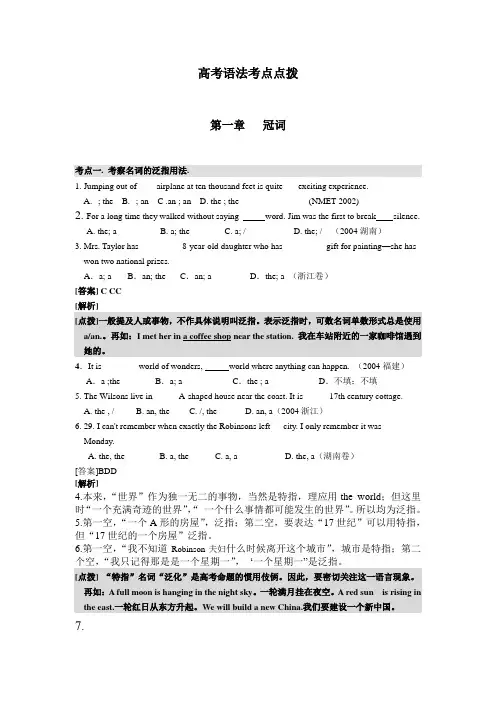
高考语法考点点拨第一章冠词考点一. 考察名词的泛指用法.1. Jumping out of____ airplane at ten thousand feet is quite ___exciting experience.A.--; theB.--; an C .an ; an D. the ; the (NMET 2002)2. For a long time they walked without saying word. Jim was the first to break silence.A. the; aB. a; theC. a; /D. the; / (2004湖南)3. Mrs. Taylor has _________ 8-year-old daughter who has _________ gift for painting—she has won two national prizes.A.a; a B.an; the C.an; a D.the; a (浙江卷)[答案] C CC[解析][点拨]一般提及人或事物,不作具体说明叫泛指。
表示泛指时,可数名词单数形式总是使用a/an.。
再如:I met her in a coffee shop near the station. 我在车站附近的一家咖啡馆遇到她的。
4.It is ________world of wonders, world where anything can happen. (2004福建)A.a ;the B.a; a C.the ; a D.不填;不填5. The Wilsons live in _____ A-shaped house near the coast. It is _____ 17th century cottage.A. the , /B. an, theC. /, theD. an, a(2004浙江)6. 29. I can't remember when exactly the Robinsons left __ city. I only remember it was ____ Monday.A. the, theB. a, theC. a, aD. the, a(湖南卷)[答案]BDD[解析]4.本来,“世界”作为独一无二的事物,当然是特指,理应用the world;但这里时“一个充满奇迹的世界”,“一个什么事情都可能发生的世界”。
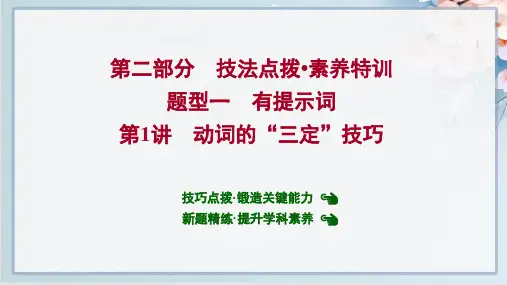
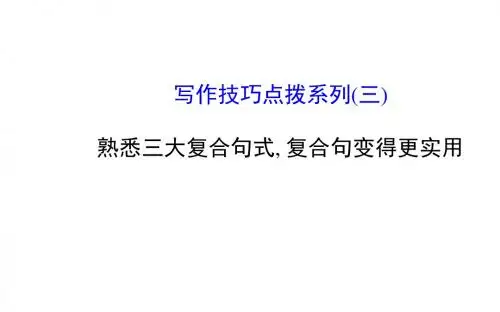

高考英语必考语法知识点归纳总结在高考英语考试中,语法是一个非常重要且必考的内容。
掌握语法知识点不仅可以帮助我们正确理解句子的含义,还可以帮助我们准确地表达自己的意思。
下面将对高考英语必考的语法知识点进行归纳总结。
一、动词及时态1.动词的基本用法:- 动词的基本形式用于表达一般情况;- 动词的过去式用于表示过去发生的动作或状态;- 动词的现在分词形式可用作形容词或进行时态的谓语;- 动词的过去分词形式可用作被动语态的谓语。
2.动词的时态:- 一般现在时:表示经常性、习惯性的动作或状态;- 现在进行时:表示正在进行的动作;- 一般过去时:表示过去某个时间发生的动作或状态;- 过去进行时:表示过去某个时间正在进行的动作;- 将来时:表示将来发生的动作或状态。
3.动词的语态:- 主动语态:表示主语进行或完成动作;- 被动语态:表示主语接受动作。
二、代词1.人称代词:- 主格代词用作主语;- 宾格代词用作宾语或介词的宾语;- 形容词性物主代词用于修饰名词;- 名词性物主代词在句中充当名词的作用;- 反身代词表示动作的主体同时也是动作的承受者。
2.指示代词:- 指示代词可用于指示距离的远近或在句中代替特定的事物。
3.不定代词:- 不定代词用于代替不确定或泛指的人或事物。
三、形容词和副词1.形容词:- 形容词修饰名词,用于描述或限定名词。
2.副词:- 副词修饰动词、形容词或其他副词,用于描述或限定动作的方式、程度等。
四、句型和从句1.简单句:- 简单句由主语和谓语构成,能够独立表达一个完整的意思。
2.并列句:- 并列句由两个或多个独立的分句组成,各分句之间用连词连接。
3.复合句:- 复合句包括一个主句和一个或多个从句。
4.定语从句:- 定语从句用来修饰一个名词或代词,并且不能独立成句。
5.名词性从句:- 名词性从句可以在句子中充当主语、宾语或表语。
五、形式和语气1.直接引语和间接引语:- 直接引语是原话的直接陈述或引述;- 间接引语是对原话的复述或改写。
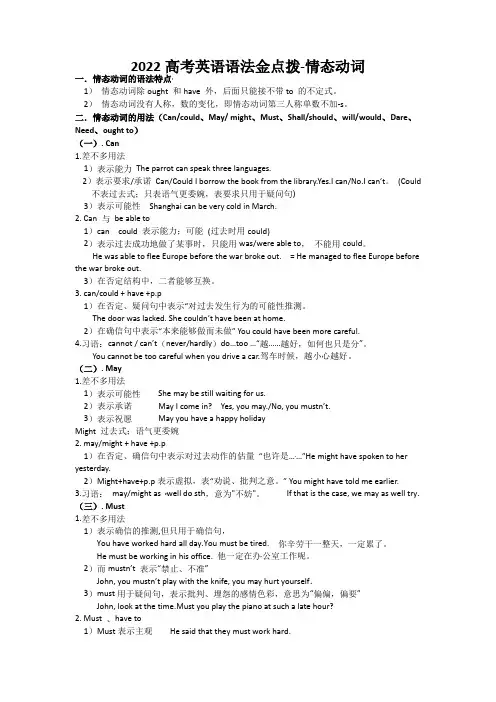
2022高考英语语法金点拨-情态动词一.情态动词的语法特点1)情态动词除ought 和have 外,后面只能接不带to 的不定式。
2)情态动词没有人称,数的变化,即情态动词第三人称单数不加-s。
二.情态动词的用法(Can/could、May/ might、Must、Shall/should、will/would、Dare、Need、ought to)(一). Can1.差不多用法1)表示能力The parrot can speak three languages.2)表示要求/承诺Can/Could I borrow the book from the library.Yes.I can/No.I can’t。
(Could 不表过去式;只表语气更委婉,表要求只用于疑问句)3)表示可能性Shanghai can be very cold in March.2. Can 与be able to1)can could 表示能力;可能(过去时用could)2)表示过去成功地做了某事时,只能用was/were able to,不能用could。
He was able to flee Europe before the war broke out.= He managed to flee Europe before the war broke out.3)在否定结构中,二者能够互换。
3. can/could + have +p.p1)在否定、疑问句中表示“对过去发生行为的可能性推测。
The door was lacked. She couldn’t have been at home.2)在确信句中表示“本来能够做而未做” You could have been more careful.4.习语:cannot / can’t(never/hardly)do…too …“越……越好,如何也只是分”。
You cannot be too careful when you drive a car.驾车时候,越小心越好。
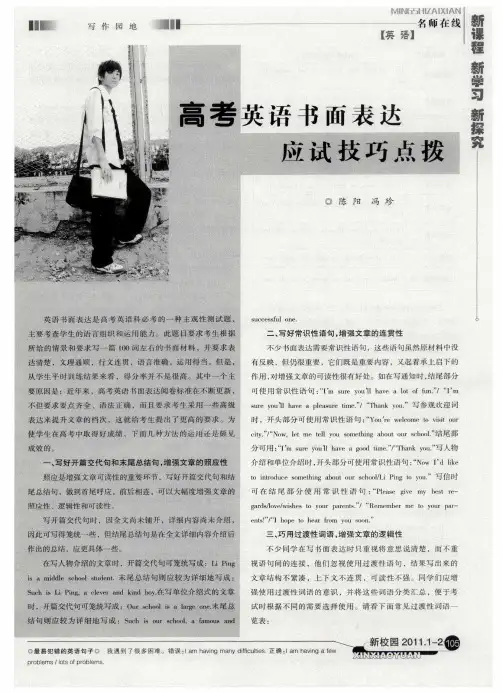
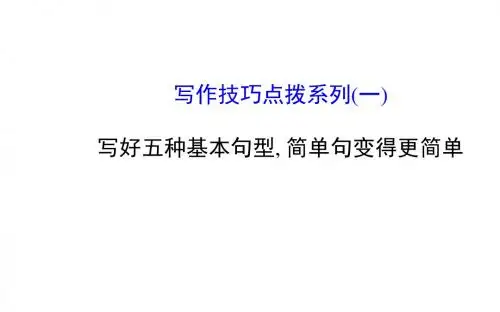
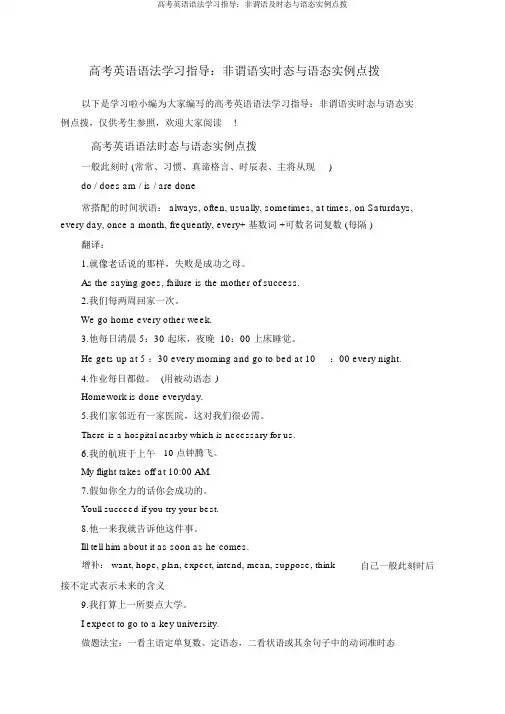
高考英语语法学习指导:非谓语实时态与语态实例点拨以下是学习啦小编为大家编写的高考英语语法学习指导:非谓语实时态与语态实例点拨,仅供考生参照,欢迎大家阅读!高考英语语法时态与语态实例点拨一般此刻时 (常常、习惯、真谛格言、时辰表、主将从现)do / does am / is / are done常搭配的时间状语: always, often, usually, sometimes, at times, on Saturdays, every day, once a month, frequently, every+ 基数词 +可数名词复数 (每隔 )翻译:1.就像老话说的那样,失败是成功之母。
As the saying goes, failure is the mother of success.2.我们每两周回家一次。
We go home every other week.3.他每日清晨 5:30 起床,夜晚 10:00 上床睡觉。
He gets up at 5 :30 every morning and go to bed at 10:00 every night.4.作业每日都做。
(用被动语态)Homework is done everyday.5.我们家邻近有一家医院,这对我们很必需。
There is a hospital nearby which is necessary for us.6.我的航班于上午10 点钟腾飞。
My flight takes off at 10:00 AM.7.假如你全力的话你会成功的。
Youll succeed if you try your best.8.他一来我就告诉他这件事。
Ill tell him about it as soon as he comes.增补: want, hope, plan, expect, intend, mean, suppose, think自己一般此刻时后接不定式表示未来的含义9.我打算上一所要点大学。
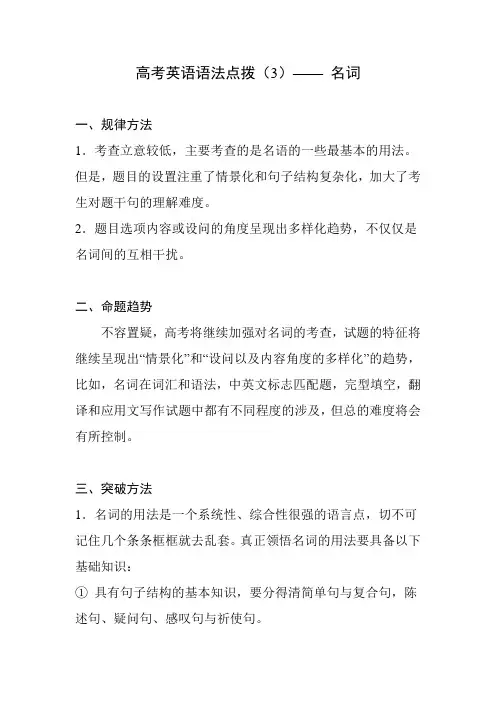
高考英语语法点拨(3)——名词
一、规律方法
1.考查立意较低,主要考查的是名语的一些最基本的用法。
但是,题目的设置注重了情景化和句子结构复杂化,加大了考生对题干句的理解难度。
2.题目选项内容或设问的角度呈现出多样化趋势,不仅仅是名词间的互相干扰。
二、命题趋势
不容置疑,高考将继续加强对名词的考查,试题的特征将继续呈现出“情景化”和“设问以及内容角度的多样化”的趋势,比如,名词在词汇和语法,中英文标志匹配题,完型填空,翻译和应用文写作试题中都有不同程度的涉及,但总的难度将会有所控制。
三、突破方法
1.名词的用法是一个系统性、综合性很强的语言点,切不可记住几个条条框框就去乱套。
真正领悟名词的用法要具备以下基础知识:
①具有句子结构的基本知识,要分得清简单句与复合句,陈述句、疑问句、感叹句与祈使句。
②具有简单句最基本的五种句型的知识,要分得清双宾语和复合宾语。
③具有扎实而丰富的名词知识,要注意名词的分类和特殊用法。
一些最基础最常用的名词应当烂熟于胸,考纲要求的词汇必须了解并掌握。
2.理解分析名词的语法功能,重点掌握名词的分类,单复数形式及其规则和不规则变化,其他特殊用法,名词的所有格用法和名词在句子中的语法成分。
3.解答考查名词的题目时,一定要保持头脑冷静。
一般要遵循以下解题思路:
①解析句子结构,确定设空在句子中充当的功能(如主语、表语、定语、宾语或补语);
②根据上下文找准相关名词在所设题目中的含义;
③搜索其他信息,确定名词的恰当形式;
④将该选项置入空中,看是否能够做到字从意顺,或是否能传达有效信息、完成交际任务,达到考核目标。
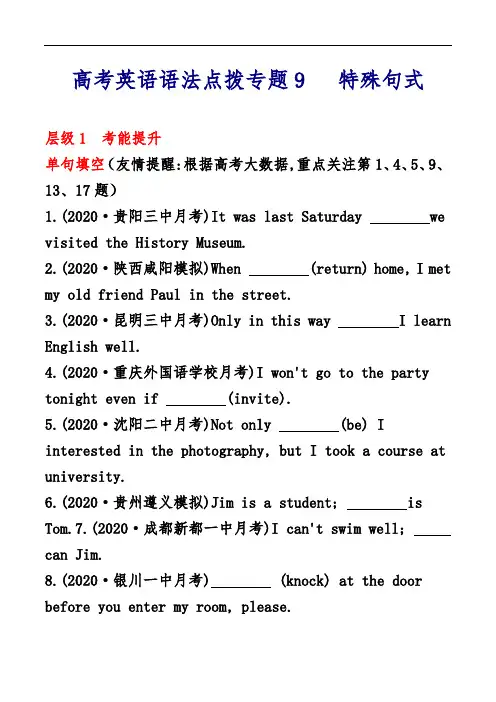
高考英语语法点拨专题9 特殊句式层级1 考能提升单句填空(友情提醒:根据高考大数据,重点关注第1、4、5、9、13、17题)1.(2020·贵阳三中月考)It was last Saturday we visited the History Museum.2.(2020·陕西咸阳模拟)When (return) home, I met my old friend Paul in the street.3.(2020·昆明三中月考)Only in this way I learn English well.4.(2020·重庆外国语学校月考)I won't go to the party tonight even if (invite).5.(2020·沈阳二中月考)Not only (be) I interested in the photography, but I took a course at university.6.(2020·贵州遵义模拟)Jim is a student; is Tom.7.(2020·成都新都一中月考)I can't swim well;can Jim.8.(2020·银川一中月考) (knock) at the door before you enter my room, please.9.(2020·贵阳三中月考)I have no idea why it ishe will go there with her.10.Though (surprise) to see us, the professor gave us a warm welcome.11.(2019·成都七中月考) (get) to the top of the tower building,where you can see the whole city.12.(2019·河北衡水一中测试)The ground is wet all over,so I'm sure it must have rained last night, it? 13.(2019·贵阳三中质检)A child,if actively(engage) in classroom activities,can be taught many things.14.(2019·江西南昌二中测试)Mike didn't understandit was that made his wife so upset this morning.15.(2019·内蒙古兴安盟模拟) in this way will you know how to arrange your time and to spend your time properly.16.(2019·河北石家庄辛集中学期中考试)No sooner (have) I got to the station than the train left.17.(2019·黑龙江佳木斯模拟)So buried (be) she in doing her homework that she didn't notice it got dark outside.18.(2019·江西红色七校联考)It was consistent love and kindness won a lifelong friendship.19.(2019·湖南长郡中学模拟)It was after Mrs Dodd became an adult she realized the strength and selflessness her father had shown in raising his children as a single parent.层级2 滚动训练Exercise 1Ⅰ.语法填空(2020·辽宁本溪高中模拟)In the workshop of a brush-pen store in Huzhou, the 29-year-old Shi Wangli makes 1. (tradition) Chinese brush-pens. Her hands are immersed (浸泡)in water for at least eight hours a day,in 2. summer and winter. The choice of the hairs in steps of making a quality brush-pen is of great 3. (important) and the work she does cannot be performed 4. a machine. It is a difficult but meaningful job. She is the youngest brush-pen technician in Huzhou. The manager of the store says he is worried the thousand-year-old technique for 5. (make) the Huzhou brush-pen used in calligraphy (书法)will be lost with few young people willing to learn it. In Chinese history, brush-penis an essential (基本的)tool for cultural inheritance (遗产). However, with the rapid progress of modern technology, brush-pens 6. (replace) firstly by pens, then ballpoint pens and now keyboards.The Ministry of Education required elementary and middle schools to start calligraphy classes 7. (save) the Chinese traditional culture. There is a general 8. (believe) that brush-pen making should be regarded as a technique 9. represents Chinese culture. People should get to know the thoughts behind these 10. (meaning) traditional techniques.Ⅱ.短文改错My little brother and I went shopping in newly opened supermarket in our city last Monday. We tasted a little delicious cheese biscuits and buy three boxes of candies. Seen one of my favourite chocolate cakes, I quickened my steps through the crowd. A few minutes late, I couldn't find my brother and got anxious. Since there were so many people in the supermarket, so it was quite tough for me to find her. I had to ask a salesman for some advices. It wasn't long after the salesman found a loudspeaker andstarted to search for my brother. Thanks for the salesman, I managed to find my brother at last.Exercise 2Ⅰ.语法填空The cheongsam is a female dress with distinctive Chinese features and enjoys growing 1. (popular) in the international world of high fashion.The name “cheongsam” 2. (mean) simply “long dress” entered the English vocabulary from the dialect of China's Guangdong Province.In other parts of the country including Beijing,however,it 3. (know) as “qipao”, which has a history behind it.After the early Manchu (满族的) rulers came to China,the Manchu women wore 4. (normal)a one-piece dress which came to be called “qipao”.5. the 1911 Revolution ended the rule of the Qing Dynasty,the female dress survived the political change and,with later improvements,has become the traditional dress for Chinese women.The cheongsam,6. neck is high,collarclosed,fits well the Chinese female figure,and its sleeves may be either short,medium or full 7.(long),depending on seasons or tastes.In addition,it is not too complicated 8. (make).Nor 9. it need too much material.Another beauty of the cheongsam is that it can be worn either 10. casual or formal occasions.In either case,it creates an impression of simple and quiet charm,elegance and neatness.Ⅱ.短文改错Great changes have been taken place since a new teaching approach is carried out in our school. In the past,our teachers almost took up all the time in class,writing on the blackboard,explain points and asking questions. Our students were just listening and busy making notes.And now,students take up most of the time in class,discussing questions,exchanging ideas,and solving problems,while teachers just give some advices. Meeting problems,we turn to the library or the Internet for help after asking teachers. I like a new teaching approach because it give me the chance to try different ways to find solutions.【答案与解析】层级1 考能提升单句填空1.that 此句为强调句型,其中被强调的部分是last Saturday。

高考英语语法讲解高考英语语法是高考英语考试中的重点内容之一。
以下是一些常见的高考英语语法知识点的讲解:1. 时态:- 一般现在时:表示经常性或普遍性的动作或状态,如“I often go to school by bus.”- 现在进行时:表示现阶段正在进行的动作,如“I am studying for the exam.”- 一般过去时:表示过去某个时间发生的动作或状态,如“He played basketball yesterday.”- 过去进行时:表示过去某一时刻正在进行的动作,如“I was watching TV when he called me.”- 现在完成时:表示过去发生的动作对现在的影响,如“I have finished my homework.”- 一般将来时:表示将来某个时间要发生的动作或状态,如“We will go shopping tomorrow.”- 未来进行时:表示将来某一时刻正在进行的动作,如“I will be studying at this time tomorrow.”2. 从句:- 定语从句:用来修饰名词或代词的从句,如“The book that you lent me is very interesting.”- 名词性从句:在句子中充当主语、宾语或表语的从句,如“Whathe said is true.”- 状语从句:用来表示时间、原因、条件、目的等的从句,如“I will call you when I arrive.”3. 语态:- 主动语态:表示主语是动作的执行者,如“He wrote a letter.” - 被动语态:表示主语是动作的承受者,如“A letter was written by him.”4. 比较级和最高级:- 比较级:用来比较两个人或物的程度,如“He is taller than his brother.”- 最高级:用来比较三个或三个以上人或物的程度,如“She is the tallest girl in the class.”5. 可数与不可数名词:- 可数名词:表示可以数的名词,如“book, apple.”- 不可数名词:表示不可以数的名词,如“water, rice.”这些是高考英语语法的一些常见知识点,掌握好这些知识点将有助于提高英语语法的应用能力,从而在高考英语考试中取得好成绩。
高考英语的语法运用技巧高考对于很多学生来说是非常重要的一次考试。
在英语科目中,语法的运用是必不可少的一项能力。
掌握好语法运用的技巧,不仅可以提高英语成绩,还能在写作和口语表达中更加准确地传达意思。
下面将介绍几种高考英语语法运用的技巧,希望对广大考生有所帮助。
一、主谓一致主谓一致是英语语法中常见的错误。
要注意主语和谓语动词在数上的一致。
如果主语是单数,谓语动词也应该是单数形式;如果主语是复数,谓语动词也应该是复数形式。
例如:The students (are) studying in the classroom.请注意,“students”是复数形式,所以谓语动词“are”也要用复数形式,而不能用单数形式“is”。
二、时态一致时态一致也是一个常见的语法错误。
要注意动词的时态与上下文的一致性。
比如,如果一句话是过去时态,那么接下来的句子也应该使用过去时态。
例如:I went to the cinema yesterday. It (was) a great movie.请注意,“went”是过去时态,接下来的句子中“was”也是过去时态。
三、定语从句定语从句是用来修饰名词的从句。
在定语从句中,要关注关系词的正确使用和位置。
例如:The book (which) is on the table is mine.请注意,这里使用的关系词是“which”,并且位于先行词“book”的后面。
四、虚拟语气虚拟语气在高考英语中经常被考察。
在虚拟语气中,要注意使用正确的动词形式。
例如:If I (were) a bird, I (could) fly in the sky.请注意,“were”是虚拟语气中表示与现实相反的动词形式;“could”是虚拟语气中表示能力的动词形式。
五、倒装句倒装句是英语语法中比较常见的句型之一。
在倒装句中,主语和谓语动词的位置颠倒过来。
例如:Not only (did) he pass the exam, but (also) he got a high score.请注意,“did”和“also”是主语和谓语动词颠倒位置后所需要的标志。
1、时间副词和地点副词一般放在句尾。
如果这两种副词同时出现在句中,则把地点副词放在时间副词的前面,也可把时间副词放在句首。
They went boating in Zhongshan Park Yesterday.=Yesterday they went boating in Zhongshan Park.他们昨天去中山公园划船了。
2、频度副词的位置:在实义动词之前,情态动词、助动词或连系动词之后。
Tom quite often goes to his mum's on Saturdays for tea.汤姆星期六经常去他妈妈家喝茶。
频度副词在“主语+助动词(be)”的省略形式中,必须放在助动词(be)之前。
—He is late.他迟到了。
—He always is.他一向如此。
3、修饰全句的副词,若放在句中或句末,必须加逗号;若位于句首则可有可无。
Nothing certainly is more important than health.的确,没有什么比健康更重要的了。
4、评论性副词可以表明我们对自己正在说的话所持的态度,或者起到连接上文的作用。
此类副词往往置于句首。
Honestly he is unfit for the job.说实话,他不适合这份工作。
5、在“动词+副词”所构成的动词短语中,宾语是代词时,放在动词与副词之间;宾语是名词时,位于副词前后皆可;宾语是短语、句子时,放在副词之后。
(1)把它放下。
正确:Put it down.错误:Put down it.(2)把你的书放下。
正确:Put down your book.正确:Put your book down.(3)把你不用的(东西)放下。
正确:Put down whatever you don't use.错误:Put whatever you don't use down.6、副词修饰名词时,一般放在该名词之后;副词(如well,right,just,soon等)修饰介词时,放在该介词之前。
高考英语点拨|语法的运用
高考英语除了单词的积累还有就是语法的运用,不论是在完形填空、短文改错还有是在作文的写作中,语法的重要性就会体现出来,现整理了有关于名词的相应语法。
名词
【要点点拨】
一. 可数名词的复数构成规则:
1.规则变化:加-s, -es; 辅音字母加y结尾的去y加ies;把f/ fe变成ves;
(1)keys , three Henrys; stomachs; safes; beliefs; proofs; roofs; gulfs; chiefs; heroes; potatoes; tomatoes; Negroes; dingoes
(2) 缩写,数字,字母等在后面加s或’s都可,如: some VIPs (VIP’s); in his 50s / 50’s; in the 1990s / 1990’s; There are two t’s in the word “letter”.
2.不规则变化:
(1) men , children , feet, teeth, geese, mice; oxen等;
(2) 单复数形式相同:sheep; deer; fish; means; works(工厂); Chinese; Japanese; Swiss; (teas, fruits, fishes, metals等表示种类);
(3)只有复数形式:trousers, glasses(眼镜);remains(遗体/物);clothes; ashes;
contents(目录); goods; customs(海关); arms(武器);
(4)复合名词的复数形式: shoe shops; lookers-on; grown-ups; passers-by; daughters-in-law
(5)表示某国人的复数形式:A:单复一样:Chinese / Japanese) B: 把man变成men : Englishmen; Frenchmen; C:其它加s (包括Germans)
一、不可数名词
1.量的表示:用some / a little / much等表示数量的词(组)及单位名词(量词),用得较多的有piece, article, bottle, head, loaf, bar等:a piece of advice / bread / news / information / equipment / chalk / cloth / clothing / music / work / furniture / paper / wood / baggage; a loaf of bread; a bar of chocolate ; two head of cattle
2.不可数名词具体化:These games are great successes; The party was a great success.
二、名词的所有格:
1.表示有生命的名词后加’s, 如一样东西为几人共有,则在最后一个名词后加’s: Jack and Tom’s room(两人共有的房间); Jack’s and Tom’s rooms(两人各自的房间);表示无生命的名词的所有格用of表示:the windows of the room;
(但表示时间、距离、国家、城市、团体、机构等无生命的名词后也可加’s: China’s industry; today’s paper; ten minutes’ walk)
2.表示“某人家里”“某店铺”等的名词所有格后省略所修饰的名词:at my aunt’s (house); at the doctor’s (office); go to the chemist’s (shop);
3.双重所有格:a / an / this / that / these / those / some / any / a few / no / every / several / such / another / which 等+名词+of +…..’s / 名词性物主代词(表示“部分”的概念或表示某种感情色彩,如:赞赏、讨厌等);
比较:
riend of her mother’s她母亲的一个朋友(强调她母亲的朋友中的一位,为双重
a friend of her mother她母亲的朋友(强调两人间的关系,为of所有格)
他弟弟的所拥有的照片中的一张,照片上不一定是他本)
a picture of his brother(他弟弟本人的一张照片,照片上就是他本人)
三、名词作定语修饰名词:前一个名词表示后一个名词的特点、性质及用途;
(1)一般前面的名词用单数形式,复数加在后面主体名词上:shoe shop(s); story book(s); coffee cup(s); physics teacher(s); 个别名词修饰另外一个名词用复数形式:sales manager; sports meet; 由man / woman与另一个名词构成复合名词两者都变复数:men/ women doctors;
(2)比较名词作定语及形容词作定语的不同意义:
a dust bag ( a bag for dust) 装灰尘的袋子/ a dusty bag布满灰尘的袋子 a chemical change化学变化(具有化学性质的变化)/ a chemistry teacher( a teacher of chemistry)一个化学老师
a gold watch 一只金表(表材质)/ a golden watch一只金黄色的表
五.英语中”很多”的表达:
:quite a few / a great many (of) / many / a (large / small) number of 只修饰不可数名词: a great deal of / a great amount of ( great amounts of)
既可修饰可数也可修饰不可数名词:plenty of / a lot of ( lots of ) / a (large) quantity of / large quantities of。